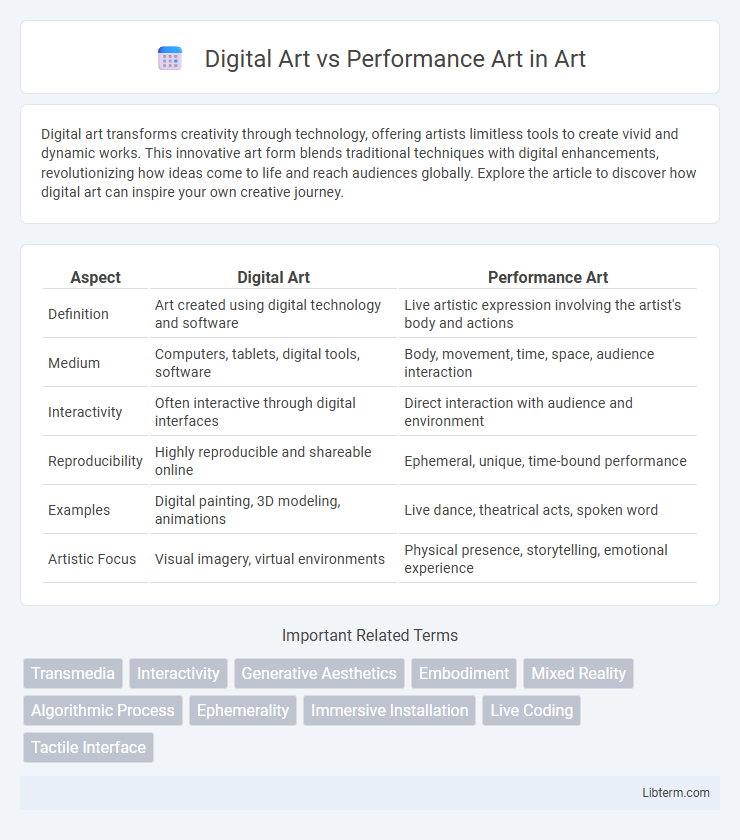Digital art transforms creativity through technology, offering artists limitless tools to create vivid and dynamic works. This innovative art form blends traditional techniques with digital enhancements, revolutionizing how ideas come to life and reach audiences globally. Explore the article to discover how digital art can inspire your own creative journey.
Table of Comparison
| Aspect | Digital Art | Performance Art |
|---|---|---|
| Definition | Art created using digital technology and software | Live artistic expression involving the artist's body and actions |
| Medium | Computers, tablets, digital tools, software | Body, movement, time, space, audience interaction |
| Interactivity | Often interactive through digital interfaces | Direct interaction with audience and environment |
| Reproducibility | Highly reproducible and shareable online | Ephemeral, unique, time-bound performance |
| Examples | Digital painting, 3D modeling, animations | Live dance, theatrical acts, spoken word |
| Artistic Focus | Visual imagery, virtual environments | Physical presence, storytelling, emotional experience |
Introduction to Digital Art and Performance Art
Digital art utilizes technology and software tools to create visual content, embracing mediums such as digital painting, 3D modeling, and interactive installations that redefine traditional artistic boundaries. Performance art centers on live presentations where the artist's actions, often ephemeral and conceptual, become the artwork itself, emphasizing human interaction and temporal experience. Exploring both forms reveals contrasting approaches to creativity: digital art's reliance on virtual tools versus performance art's embodiment of presence and physical expression.
Defining Digital Art: Techniques and Tools
Digital art encompasses creative expressions that utilize digital technology as an essential part of the production or presentation process, including techniques such as digital painting, 3D modeling, and algorithmic art. Key tools include graphic tablets, software like Adobe Photoshop, Blender, and Procreate, alongside hardware such as VR headsets and motion capture systems. These technologies enable artists to manipulate pixels, generate complex visual effects, and create immersive experiences unattainable in traditional performance art.
Understanding Performance Art: Origins and Practices
Performance art originated in the 1960s as a multidisciplinary practice combining visual art, theater, and dance to challenge traditional art forms. It emphasizes live presentations and the artist's physical presence, often incorporating audience interaction and temporal experiences. Rooted in concepts of identity, politics, and social commentary, performance art prioritizes process and experience over permanent objects.
Key Differences Between Digital and Performance Art
Digital art utilizes technology and software to create visual or interactive pieces, often existing in virtual or digital formats, while performance art centers on live actions and human presence as the medium of expression. Digital art emphasizes manipulation of digital tools like graphic design, 3D modeling, or animation, contrasting with performance art's reliance on physical movement, time-based interaction, and audience engagement. The ephemeral nature of performance art contrasts with digital art's potential for replication, distribution, and preservation across various digital platforms.
Intersecting Mediums: Hybrid Art Forms
Digital art and performance art increasingly converge through hybrid art forms that blend technology and live expression, creating immersive, multisensory experiences. Artists integrate digital projections, interactive installations, and virtual reality with physical performance to expand narrative possibilities and audience engagement. This intersection challenges traditional boundaries, fostering innovative collaborations and new techniques within contemporary art practice.
Impact of Technology on Artistic Expression
Digital art harnesses advanced software, virtual reality, and interactive platforms to expand creative possibilities, enabling artists to manipulate images and environments in ways traditional media cannot. Performance art integrates technology through live streaming, multimedia projections, and wearable devices, transforming the audience's experience into participatory and immersive events. Both forms reflect evolving artistic expression driven by innovations in digital tools, blurring boundaries between creator, medium, and viewer.
Audience Engagement: Virtual vs Physical Experience
Digital art leverages virtual platforms to create immersive, interactive experiences that engage global audiences through real-time feedback and participatory elements. Performance art relies on physical presence, enabling direct sensory interaction and spontaneous emotional exchange between artist and audience. The distinction lies in digital art's scalability and accessibility versus performance art's tangible immediacy and communal atmosphere.
Notable Artists in Digital and Performance Art
Notable digital artists include Refik Anadol, known for immersive AI-driven installations, and Beeple, whose blockchain-based digital artworks have revolutionized NFT markets. Performance art features iconic figures such as Marina Abramovic, whose endurance-based pieces challenge audience interaction, and Yoko Ono, whose conceptual works integrate audience participation and social commentary. Both mediums push the boundaries of artistic expression through technology and live experience, influencing contemporary art discourse globally.
Cultural and Social Implications
Digital art reshapes cultural narratives by enabling widespread access and interaction, fostering global connectivity and democratizing artistic participation through virtual platforms. Performance art challenges societal norms by emphasizing live presence and embodied experience, often addressing political and social issues in real-time public contexts. Both mediums influence cultural dialogue, with digital art expanding virtual communities while performance art provokes immediate social engagement and critical reflection.
Future Trends in Art: Blurring the Boundaries
Digital art and performance art are converging through immersive technologies like augmented reality (AR) and virtual reality (VR), creating hybrid experiences that dissolve traditional boundaries between static and live expressions. Emerging tools such as AI-generated visuals and interactive installations enable artists to engage audiences in dynamic, multisensory environments. The future of art increasingly favors fluidity between mediums, fostering innovative collaborations that challenge and expand conventional definitions of artistic practice.
Digital Art Infographic

 libterm.com
libterm.com